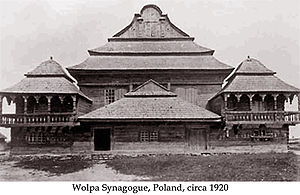
Wolpa Synagogue
Encyclopedia

Synagogue
A synagogue is a Jewish house of prayer. This use of the Greek term synagogue originates in the Septuagint where it sometimes translates the Hebrew word for assembly, kahal...
in the town of Wołpa (alternative spellings: Wolpa , Volpe , Wolpe , Wolp , Woupa or Voupa
Voupa
Voupa is a town near Bialystok, Poland, now in Western Belarus.It was noted for the Wolpa Synagogue, reputed to be the "most beautiful" of the Wooden synagogues of Eastern Europe, a "masterwork" of wooden architecture.-References:...
) near Bialystok
Bialystok
Białystok is the largest city in northeastern Poland and the capital of the Podlaskie Voivodeship. Located on the Podlaskie Plain on the banks of the Biała River, Białystok ranks second in terms of population density, eleventh in population, and thirteenth in area, of the cities of Poland...
, Poland
Second Polish Republic
The Second Polish Republic, Second Commonwealth of Poland or interwar Poland refers to Poland between the two world wars; a period in Polish history in which Poland was restored as an independent state. Officially known as the Republic of Poland or the Commonwealth of Poland , the Polish state was...
, now in Western Belarus
Belarus
Belarus , officially the Republic of Belarus, is a landlocked country in Eastern Europe, bordered clockwise by Russia to the northeast, Ukraine to the south, Poland to the west, and Lithuania and Latvia to the northwest. Its capital is Minsk; other major cities include Brest, Grodno , Gomel ,...
. It was reputed to be the "most beautiful" of the Wooden synagogues of Eastern Europe
Wooden synagogues of Eastern Europe
Wooden synagogues are an original style of Synagogue architecture that developed in the Polish-Lithuanian commonwealth.- Uniqueness as an artistic and architectural form :...
, a "masterwork" of wooden architecture.
History
The synagogue was built in the first half of the eighteenth century, and altered in minor ways several times. In 1929 the building was listed as a Polish Monument of Culture. It was burnt by the Germans during the Second World War.Architecture
The main hall was 13 meters by 12.80 meters with a vaulted ceiling described by art historians Maria and Kazimierz Piechotka as having been "the most magnificent of all known wooden ceilings" in Europe. Of course, since Christians were free to build with brick and stone, few European buildings of the scale of the Wolpa synagogue were ever built in wood. The walls of the main hall were 7.2 meters high. The vaulting, under a three-tiered roof, rose to a height of fourteen meters in three tiers marked by fancy balustrades. Each tier was made up of several curving sections faced in wooden paneling to form a graceful, tiered and vaulted dome. The vaulted ceiling was supported by the four wooden corner columns that rose from the bimah, and by trusses in the roof.The Torah Ark was an elaborate, multi-tiered confection in painted, carved wood, with columns, bas-relief menorahs, vases, floral swags, roofed towers, the tablets of the Ten Commandments and an eagle.
In the early nineteenth century, the vaulted ceiling was painted in a "dark sapphire" color spangled with "glistening" gold stars. The walls were painted in naive Trompe-l'œil style to resemble a Classical masonry building. Polish Jewish communities were routinely denied permission to build in masonry.
The exterior featured a three-tiered roof and a pair of elaborage corner pavilions with two-tiered roofs over elaborate vaulted ceilings.
In 1997, the Yiddish Book Center on the campus of Hampshire College in Amherst, Massachusetts, the world's largest repository of Yiddish books and literature, chose to model its building on existing photographs of the Wolpa Synagogue.

